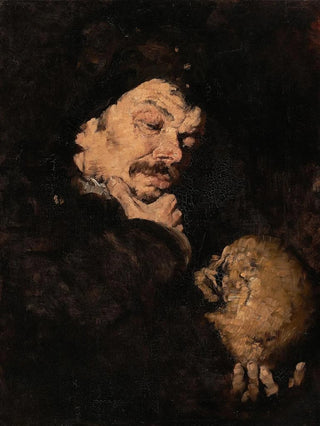Art print | Man holding a skull - Frank Duveneck


View from behind

Frame (optional)
"Homme tenant un crâne" by Frank Duveneck is a masterpiece that embodies the depth of human reflection. This painting, both striking and enigmatic, immerses us in a universe where life and death coexist. By observing this artwork, the viewer is immediately drawn to the posture of the central figure, who, with palpable intensity, seems to meditate on the fragility of existence. This art print, through its subject and execution, invites us to explore universal themes such as mortality, contemplation, and the ephemeral nature of life. The art print of this piece allows everyone to access an intimate and personal reflection on our human condition.
Style and uniqueness of the work
Duveneck's style is characterized by a remarkable mastery of light and shadow, creating an atmosphere that is both dramatic and introspective. In "Homme tenant un crâne," the color palette, dominated by dark and earthy tones, emphasizes the serious nature of the subject. The artist's technique, which blends realism and expressionism, gives this work a unique emotional power. The skull, a symbol of mortality, is held with a delicacy that contrasts with the gravity of its message. This duality is at the heart of the work, inviting the viewer to reflect on life while confronting death. Duveneck succeeds in capturing a deep human essence, revealing his talent to transcend simple representation and touch the intimate.
The artist and his influence
Frank Duveneck, an emblematic figure of the American realist movement of the 19th century, made his mark by his innovative approach to painting. Born in Cincinnati, he was heavily influenced by European masters during his stays in Europe, notably in Venice and Munich. His style, which combines tradition and modernity, has inspired many contemporary artists and contributed to the evolution of American art. By incorporating elements of everyday life into his works, Duveneck paved the way for a new form of artistic expression, where the psychology of the characters is emphasized.

Matte finish

View from behind

Frame (optional)
"Homme tenant un crâne" by Frank Duveneck is a masterpiece that embodies the depth of human reflection. This painting, both striking and enigmatic, immerses us in a universe where life and death coexist. By observing this artwork, the viewer is immediately drawn to the posture of the central figure, who, with palpable intensity, seems to meditate on the fragility of existence. This art print, through its subject and execution, invites us to explore universal themes such as mortality, contemplation, and the ephemeral nature of life. The art print of this piece allows everyone to access an intimate and personal reflection on our human condition.
Style and uniqueness of the work
Duveneck's style is characterized by a remarkable mastery of light and shadow, creating an atmosphere that is both dramatic and introspective. In "Homme tenant un crâne," the color palette, dominated by dark and earthy tones, emphasizes the serious nature of the subject. The artist's technique, which blends realism and expressionism, gives this work a unique emotional power. The skull, a symbol of mortality, is held with a delicacy that contrasts with the gravity of its message. This duality is at the heart of the work, inviting the viewer to reflect on life while confronting death. Duveneck succeeds in capturing a deep human essence, revealing his talent to transcend simple representation and touch the intimate.
The artist and his influence
Frank Duveneck, an emblematic figure of the American realist movement of the 19th century, made his mark by his innovative approach to painting. Born in Cincinnati, he was heavily influenced by European masters during his stays in Europe, notably in Venice and Munich. His style, which combines tradition and modernity, has inspired many contemporary artists and contributed to the evolution of American art. By incorporating elements of everyday life into his works, Duveneck paved the way for a new form of artistic expression, where the psychology of the characters is emphasized.






